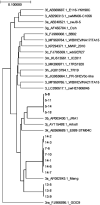Detection of hepatitis E virus RNA from pig bile collected at a slaughterhouse in Japan
- PMID: 36694587
- PMCID: PMC9834074
- DOI: 10.3934/microbiol.2022036
Detection of hepatitis E virus RNA from pig bile collected at a slaughterhouse in Japan
Abstract
Hepatitis E virus (HEV) is a zoonotic pathogen that circulates mainly between pigs and humans. In Japan, the number of confirmed HEV cases has increased over the past decade, with the majority reported as domestic HEV infections. HEV-infected pork products may be associated with this increase, but there is limited information on HEV in pork in Japanese markets. From February to March 2020, gallbladders were collected from 200 slaughtered pigs shipped from 14 farms and were surveyed to detect HEV RNA in bile using reverse transcription quantitative polymerase chain reaction. The samples were then sequenced and genotyped. Twenty pigs were positive for HEV ribonucleic acid, and seven samples had Ct values of less than 30. Among these 20 pigs, virus strains from 14 pigs were determined as genotype 3. This report indicated that HEV-contaminated pork liver was shipped to consumer markets and demonstrated the importance of detection of HEV in meat ready for shipment.
Keywords: hepatitis E virus; liver; pig, bile; slaughterhouse.
© 2022 the Author(s), licensee AIMS Press.
Conflict of interest statement
Conflict of interest: The authors declare no conflict of interest.
Figures


Similar articles
-
High Hepatitis E virus (HEV) Positivity Among Domestic Pigs and Risk of HEV Infection of Individuals Occupationally Exposed to Pigs and Pork Meat in Hanoi, Vietnam.Open Forum Infect Dis. 2019 Jun 26;6(9):ofz306. doi: 10.1093/ofid/ofz306. eCollection 2019 Sep. Open Forum Infect Dis. 2019. PMID: 31660396 Free PMC article.
-
Detection of Hepatitis E Virus in Raw Pork and Pig Viscera As Food in Hebei Province of China.Foodborne Pathog Dis. 2019 May;16(5):325-330. doi: 10.1089/fpd.2018.2572. Epub 2019 Feb 26. Foodborne Pathog Dis. 2019. PMID: 30807231
-
Hepatitis E Virus in Pork and Variety Meats Sold in Fresh Markets.Food Environ Virol. 2017 Mar;9(1):45-53. doi: 10.1007/s12560-016-9258-0. Epub 2016 Aug 31. Food Environ Virol. 2017. PMID: 27580911
-
Potential Approaches to Assess the Infectivity of Hepatitis E Virus in Pork Products: A Review.Food Environ Virol. 2017 Sep;9(3):243-255. doi: 10.1007/s12560-017-9303-7. Epub 2017 May 3. Food Environ Virol. 2017. PMID: 28470455 Review.
-
Zoonotic origin of hepatitis E.Curr Opin Virol. 2015 Feb;10:34-41. doi: 10.1016/j.coviro.2014.12.006. Epub 2015 Jan 9. Curr Opin Virol. 2015. PMID: 25588602 Review.
Cited by
-
Hepatitis E Virus RNA Detection in Liver and Muscle Tissues Sampled from Home Slaughtered Domestic Pigs in Central Italy.Food Environ Virol. 2024 Dec;16(4):438-448. doi: 10.1007/s12560-024-09606-2. Epub 2024 Jun 11. Food Environ Virol. 2024. PMID: 38862750 Free PMC article.
-
Hepatitis E Virus Infection Caused Elevation of Alanine Aminotransferase Levels in a Patient with Chronic Hepatitis B and Choledocholithiasis.Reports (MDPI). 2023 Nov 17;6(4):55. doi: 10.3390/reports6040055. Reports (MDPI). 2023. PMID: 40729178 Free PMC article.
-
Hepatitis E Virus in Domestic Ruminants and Virus Excretion in Milk-A Potential Source of Zoonotic HEV Infection.Viruses. 2024 Apr 26;16(5):684. doi: 10.3390/v16050684. Viruses. 2024. PMID: 38793568 Free PMC article. Review.
-
Hepatitis E Virus in Livestock-Update on Its Epidemiology and Risk of Infection to Humans.Animals (Basel). 2023 Oct 17;13(20):3239. doi: 10.3390/ani13203239. Animals (Basel). 2023. PMID: 37893962 Free PMC article. Review.
-
Serological and Molecular Survey of Hepatitis E Virus in Small Ruminants from Central Portugal.Food Environ Virol. 2024 Dec;16(4):516-524. doi: 10.1007/s12560-024-09612-4. Epub 2024 Sep 5. Food Environ Virol. 2024. PMID: 39235492 Free PMC article.
References
-
- National Institute of Infectious Diseases: Infectious Diseases Weekly Report Japan, 2020. Available from: https://www.niid.go.jp/niid/ja/ydata/10411-report-ja2020-20.html.
-
- National Institute of Infectious Diseases: Infectious Agents Surveillance Report. Available from: https://www.niid.go.jp/niid/images/idsc/iasr/42/502.pdf.
LinkOut - more resources
Full Text Sources
Miscellaneous
